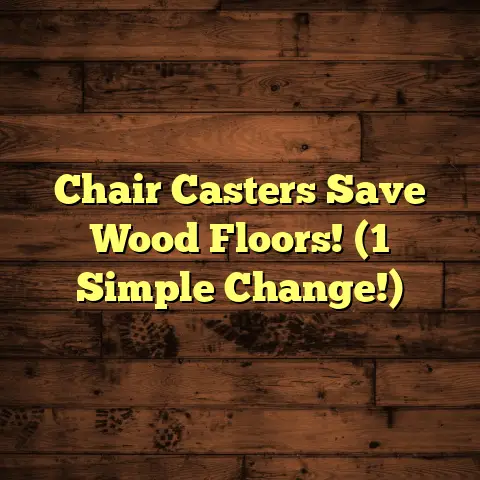When Were Wood Floors Invented? (True Origin!)
It’s more than just planks beneath our feet; it’s a journey through time, craftsmanship, and the evolution of style. Let’s dive deep into the fascinating history of wood floors, from ancient times to the modern marvels we see today.
The Allure of Wood Flooring Throughout History
Wood. It’s been a cornerstone of construction since, well, forever! Its use wasn’t just about building shelter; it was about creating a statement. Think about it: a sturdy wooden structure, a warm, inviting space.
From the earliest civilizations, wood has been synonymous with quality, durability, and, yes, even affluence.
Imagine the homes of the wealthy in ancient times. Stone floors were cold and unforgiving. Dirt floors? Unhygienic and, frankly, unpleasant. Wood offered a solution: warmth, comfort, and a touch of elegance.
While detailed records are scarce, archaeological evidence suggests that even rudimentary forms of wood flooring were a sign of status.
Think of the European nobility during the Renaissance. Their castles weren’t just built of stone; they were adorned with intricate wooden details, including stunning floors. These weren’t just functional; they were works of art!
The Early Origins of Wood Flooring
Okay, so when did this love affair with wood flooring really begin? It’s tough to pinpoint an exact date, but archaeological digs give us some clues.
We’re talking thousands of years ago! Some of the earliest examples come from archaeological sites in Europe and the Middle East.
These weren’t your fancy parquet patterns. We’re talking rough-hewn planks, likely laid directly onto the earth or a simple foundation. But hey, it was a start!
What kind of trees were they using? That depended on what was available locally. Oak, pine, and other hardwoods were common choices, valued for their strength and durability.
The techniques? Primitive, to say the least. Think axes, hand saws, and a whole lot of elbow grease.
These early installations were far from perfect, but they represented a significant step up from bare earth or stone.
Evolution of Wood Flooring Techniques
Fast forward through the centuries, and you see some serious advancements. The Middle Ages saw improvements in woodworking tools, leading to more precise cuts and smoother surfaces.
Then came the Renaissance. Oh, the Renaissance! This era brought an explosion of creativity and craftsmanship. Parquetry, with its intricate geometric patterns, became all the rage. Inlays, using different types of wood to create stunning designs, added another layer of luxury.
Think Versailles. Those floors are legendary.
The development of tools like the plane and the improved saw made a huge difference. Craftsmen could now create more uniform planks and more complex designs.
It wasn’t just about function anymore; it was about creating a visual masterpiece underfoot.
Regional Variations in Wood Flooring
Here’s where things get really interesting. Different cultures put their own spin on wood flooring, adapting to their unique environments and aesthetic preferences.
In Europe, you saw a lot of oak and other hardwoods, often laid in elaborate patterns. Asian styles often incorporated bamboo or other locally sourced materials.
In America, the early colonists used what they had available: pine, maple, and other native woods.
Colonialism and trade also played a huge role. Exotic woods from far-flung corners of the world started making their way into European homes, adding a touch of the exotic.
For example, mahogany from the Americas became a prized material for high-end flooring.
The Industrial Revolution and Mass Production
The Industrial Revolution changed everything, including the world of wood flooring. New machinery and techniques allowed for mass production, making wood floors more accessible to the masses.
Sawmills powered by steam engines could churn out planks at a fraction of the time and cost of hand-sawing.
This meant that wood flooring was no longer just for the wealthy elite. The middle class could now afford to have beautiful wood floors in their homes.
This shift also changed the perception of wood flooring. It went from being a symbol of extreme luxury to a more common, yet still desirable, household feature.
Modern Advances in Wood Flooring
Today, we have more choices than ever before. Engineered wood, with its layered construction, offers increased stability and resistance to moisture. Laminate flooring provides a budget-friendly alternative that mimics the look of real wood.
Sustainability is also a major focus. Responsible sourcing and production practices are essential to ensure that we can continue to enjoy the beauty of wood flooring for generations to come.
According to the National Wood Flooring Association (NWFA), sustainable forestry practices are becoming increasingly important to consumers.
Here are some current trends in wood flooring design:
- Wide planks: These create a more modern and spacious feel.
- Matte finishes: These offer a more natural and understated look.
- Gray tones: These are incredibly popular, providing a neutral backdrop for any décor.
- Herringbone patterns: These add a touch of classic elegance.
The Cultural Impact of Wood Flooring
Wood flooring isn’t just a building material; it’s a cultural symbol. It represents warmth, comfort, and a connection to nature.
Think about how wood floors are often featured in art, literature, and film. They’re used to create a sense of luxury, sophistication, and homey comfort.
A character pacing across a creaky wooden floor in a suspenseful movie? That’s classic!
The feeling of bare feet on a warm wood floor on a cold morning? That’s priceless.
Wood floors evoke a sense of history, tradition, and timeless beauty.
Here’s a personal story: I once worked on restoring a historic home in Charleston, South Carolina. The original heart pine floors were over 200 years old, and they were stunning. You could feel the history beneath your feet, the stories of generations who had walked those same planks. It was an incredibly humbling experience.
Conclusion: The Timeless Appeal of Wood Flooring
From its humble beginnings in ancient times to its modern-day luxury status, wood flooring has come a long way. It’s a testament to the enduring appeal of natural materials, the skill of craftsmen, and the desire for beauty and comfort in our homes.
Wood floors continue to be a popular choice for homeowners and designers alike. According to a recent survey by Floor Covering News, wood flooring remains one of the top three flooring choices for new homes.
Whether it’s a rustic farmhouse, a sleek modern apartment, or a grand historic mansion, wood flooring has the power to transform any space.
So, the next time you walk across a wood floor, take a moment to appreciate its rich history and timeless beauty. It’s more than just a floor; it’s a piece of art, a connection to the past, and a symbol of enduring style.
The future of wood flooring? I believe we’ll see even more innovation in terms of sustainability, design, and technology. But one thing will remain constant: the timeless appeal of wood underfoot.
What are your thoughts? What kind of wood floors do you have in your home? I’d love to hear your stories!





